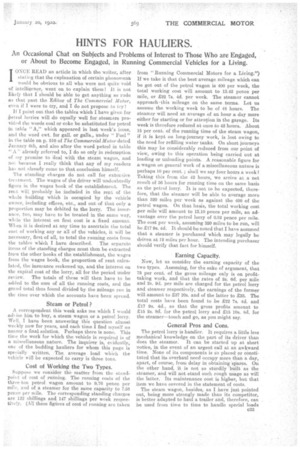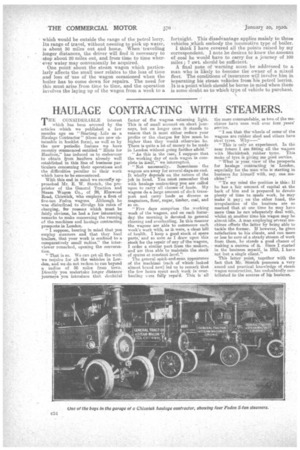HINTS FOR HAULIERS.
Page 21

Page 22

If you've noticed an error in this article please click here to report it so we can fix it.
An Occasional Chat on Subjects and Problems of Interest to Those Who are Engaged, or About to Become Engaged, in Running Commercial Vehicles for a Living.
IONCE READ an article in which the writer, after. stating that the explanation of certain phenomena would be obvious to all who were not quite void of intelligence, went on to explain them! It is not likely that I should be able to get anything so rude as that past the Editor of The Commercial Motor, even if I were to try, and I do not propose to tryl If I point out that the tables which I have given for betrol lorries will do equally well for steamers provided the words coal or coke be substituted for petrol in table "A," which appeared in last week's issue, and the word cwt. for gall, or galls., Under " Fuel" in the table on p. 510 of the Commercial Motor dated January 6th, and also after the word petrol in table " A " already referred to, I do so only in redemption of my promise to deal with the steam, wagon, and not because I really think that any of my rea-ders has not already come to that conclusion himself.
The standing charges do not call for extensive treatment. The wages of the driver will undoubtedly figure in the wages book of the establishment. The rent will probably be included in the rent of the whole building which is occupied by the vehicle owner, including offices, etc., and out of that only a proportion may be debited to the lorry. The instilanee, too, may have to be treated in the same way, while the interest on first cost is a fixed amount. When it is desired at any time to ascertain the total cost of working any or all of the vehicles, it will be necessary, first of all, to total the running -costs from the tables which I -have described. The separate items of the standing charges must then. be extracted from the other books of the establishment, the wages from the wages book, the proportion of rent calculated, the insurance reckoned up, and the interest on the capital. cost of the lorry, all for the period under review. The totals of these will then have to be added to the sum of all the running costs, and the grand total thus found divided by the Mileage run in the time over which the accounts have been spread.
Steam or Petrol ?
A correspondent this week asks me which I would advise him to buy, a steam wagon or a petrol lorry. Well. II have been answering this question almost weekly now for years, and each time I find myself no nearer a final solution. Perhaps there is none. This time the work for which the vehicle is required is of a miscellaneous nature. The inquirer is, evidently, one of the budding hauliers for whom this page is specially written. e The, average load -which the vehicle will be exeected to carry is three tons.
Cost of Working, the Two Types.
Suppose we consider the matter from the standpoint of cost of running. The running casts of the three-ten petrol Wagon amount to 9.76 pence per mile, and of a steamer for the same capacity to 7.58 pence per mile. The corresponding standing charges are 122 shillings and 147 shillings per week respectively. (All these figures of cost of running are taken from " Running Commercial Motors for a Living.") If -we take it that the best average mileage which can be got out of the petrol wagon is 400 per week, the total working -cost will amount to 13.42 pence per mile, or 222 7s. 4d. per week. The steamer cannot approach•this mileage on the same terms. Let us assume the working week to be of 48 hours. The steamer will need an average of an hour a day more either for starting or for attention in the garage. Its week is therefore reduced at once to 42 hours. About 15 per cent, of the running time of the steam wagon, if it is kept on long-journey work, is Jost owing to the need for refilling water tanks. On short journeys this may be considerably reduced from our point of view, owing to this operation being carried out at loading or unloading points. A reasonable figure for a wagon on general work of a miscellaneous nature is perhaps 10 per cent. ; shall we say four hours a week? Taking this from the 42 hours, we arrive at a net result of 36 hours for running time on the same basis as the petrol lorry. It is not to be expected, therefore, that the steamer will be able to average more than 320 miles per week as against the 400 of the petrol wagon. On that basis, the total working cost per mile will amount to 13l0 pence per mile, an advantage over the petrol lorry of 0.32 pence per mile. The cost per week, assuming 320 -miles to be run, will be 217 9s. 4d. It should be noted that I have assumed that a steamer is purchased which may legally be driven at 12 miles per hour. The intending purchaser should verify that fact for himself.
Earning Capacity.
Now, let -us consider the earning capacity of the two types. Assuming, for the sake of argument, that 75 per cent. of the gross mileage only is on profittaking work, and that the rates of 2s. 6d. per mile and 2s. ad, per mile are charged for the petrol lorry and steamer respectively, the earnings of the former will amount to 237 105. and of the latter to -233. The total costs have been found to be 222 7s. 4d. and 217 9s. 4d., so that the gross profits amount to 215 2s. 8d. for the petrol lorry and 215 10s. 8d. for the steamer—touch and go, as you might say.
General Pros and Cons.
The petrol lorry is handier. It requires a little less mechanical knowledge on the part of its driver than does the steamer. It can be started -up at short notice, in the event of an urgent call at an awkward time. None of its components is placed or constituted that its overhaul need occupy more than a day, apart, of course' from delay in obtaining spares. On the other hand, it is not so sturdily built as the -steamer, and will not stand such rough usage as will the latter. Its maintenance cost is higher, but that item we have covered in the statement of costs.
The steam wagon, besides as I have just pointed out, being more strongly made than its competitor, is better adapted to haul a trailer and, therefore, can be used from time to time to handle special loads which would be outside the range of the petrol lorry. Its range of travel, without needing to pick up water, Is about 30 miles out and home. When travelling longer distances, the driver will find it necessary to • stop about 20 miles out, and from time to time wherever water may oonvemently be acquired.. One point about the steam wagon which particularly affects the small user relates to the loss of time and lass of use of the wagon occasioned when the boiler has to come down for repairs. The need for this must arise from time to time, and the operation involves the laying up of the wagon from a week to a fortnight. This disadvantage applies mainly to those vehicles .which embody the locomotive type of boiler. I think I have covered all the points raised by my correspondent. I note he desires to know the amount of coal he would have to carry for a journey of 100 miles ; 7 cwt. should be sufficient.
A final note of warning must be addressed to a man who is likely to become the owner of a mixed fleet. The conditions of insurance will involve him in 'separating his steam vehicles from his petrol lorries. It is a point which should be borne in mind when there is some doubt as to which type of vehicle -to purchase.




























